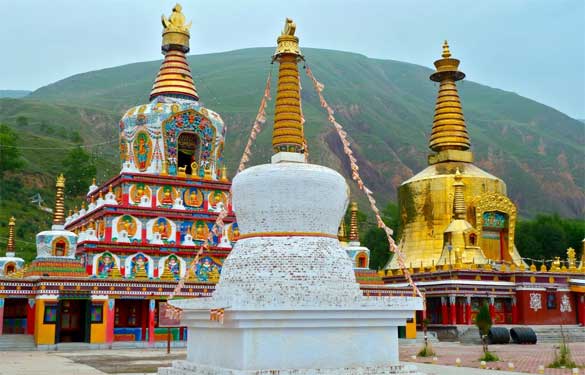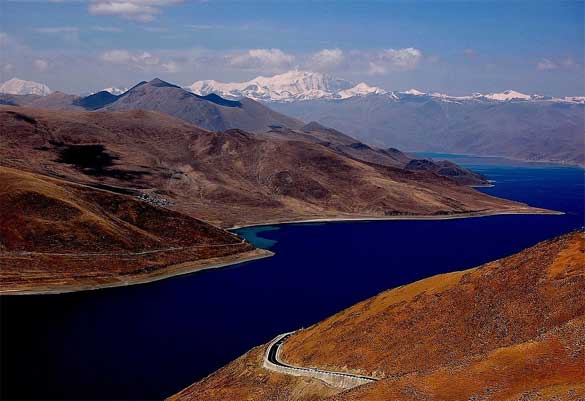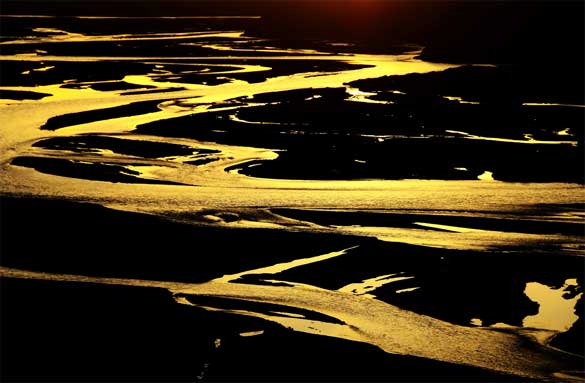
Stupas of Kalachakra, Tongren monastery – Image Source: Sekitar
If you have not been to Northwest China, you will not know how vast China’s territory is. If you have not been to Qinghai, you cannot imagine how spectacular North west China is. Come to Qinghai and ascend the Qinghai-Tibet Plateau, the “roof of the world,” and you will feel as if you could touch the sky.
Qinghai Province lies in Northwest China and on the northeastern part of the Qinghai Tibet Plateau. With an area of 721,200 square kilometers, Qinghai is China’s fourth largest provincial-level regions, next only to Xinjiang Uygur Autonomous Region, Tiber Autonomous Region and Inner Mongolia Autonomous Region. People of minority ethnic groups, mainly the Tibetan, Hui, Tu, Salar and Mongolian. account for 46 percent of Qinghai’s total population of over 5.5 million.The province is the source of the Yangtze River, Yellow River and Lancang River, home to the Tibetan antelope – one of the mascots of the Beijing 2008 Olympic Garnes named Ying ying – and the place of origin of the Kunlun Jade which is inlaid on the Olympic medals.

Yangcuoyong Lake, Tibet – Photo Credit: Gao
An ancient Chinese philosopher said, “Nature shows ils grandeur without saying anything about it.” With its vast land, rich resources, rnagnificen t mountains, si mple and honest people and time-honored ethnic culture, Qinghai is a place of stunning beauty with distinctive characters.
Qinghai’s charm lies in its daz zling glaciers and numerous rivers and lakes. Known as “China’s water tower,” the province is the most important water source of the country.
Qinghai has the world’s largest alpine wetland, alpine grassland, shrub grove and forest. The local eco-system is greatly diversified with a large variety of species. It is one of the centers where China’s species developed and evolved, and is renowned as a unique eco logical area in the world. It is recognized by the United Nations Educational, Scientific and Cultural Organization as one of the four most pollution-free regions in the world.

Yellow River, Qinghai Plateau – Photo Credit: Melinda
Qinghai’s charm lies in its long history and multiethnic and plural cultures. Human beings began to live in this area more than 30,000 years ago. Xiaochaidan Culture of the Paleolithic era, Majiayao Culture of the Neolithic era, Xindian Culture of the Bronze Age and indigenous Kayue Culture distributed across the Hehuang region represent Qinghai’s brilliant ancient civilization.
Qinghai is not only one of the important cradles of the Chinese civilization, but also a bridge for cultural exchanges between the Central Plain and its surrounding regions and between China and foreign countries. It was a commercial hub on the ancient Tang-Tubo Route and the Silk Road. As a melting pot of different cultures, the Qinghai Plateau has nurtured a rich and distinctive civilization.
Qinghai’s charm also lies in its breathtaking natural scenery, which makes it a favorite destination of plateau travelers. Qing hai’s average altitude is more than 3,000 meters. The Kunlun Mountains bisect the prov ince from east to west. To the south and north of the Kunlun Mountains tower the Tanggula Mountains, the Bayan Har Mountains and the Qilian Mountains. Qinghai is blessed with snow-capped peaks, boundless grasslands, vast Gobi Deserts as well as the fertile Hehuang region. The beautiful province unfolds a pristine, intact, magnificent and wonderful picture before visitors.
People in Qinghai welcome visitors from around the world with their breathtaking natural scenery, rich ethnic culture and diver sified plateau ecosystems.
You may also love reading “Healing powers of travelling“